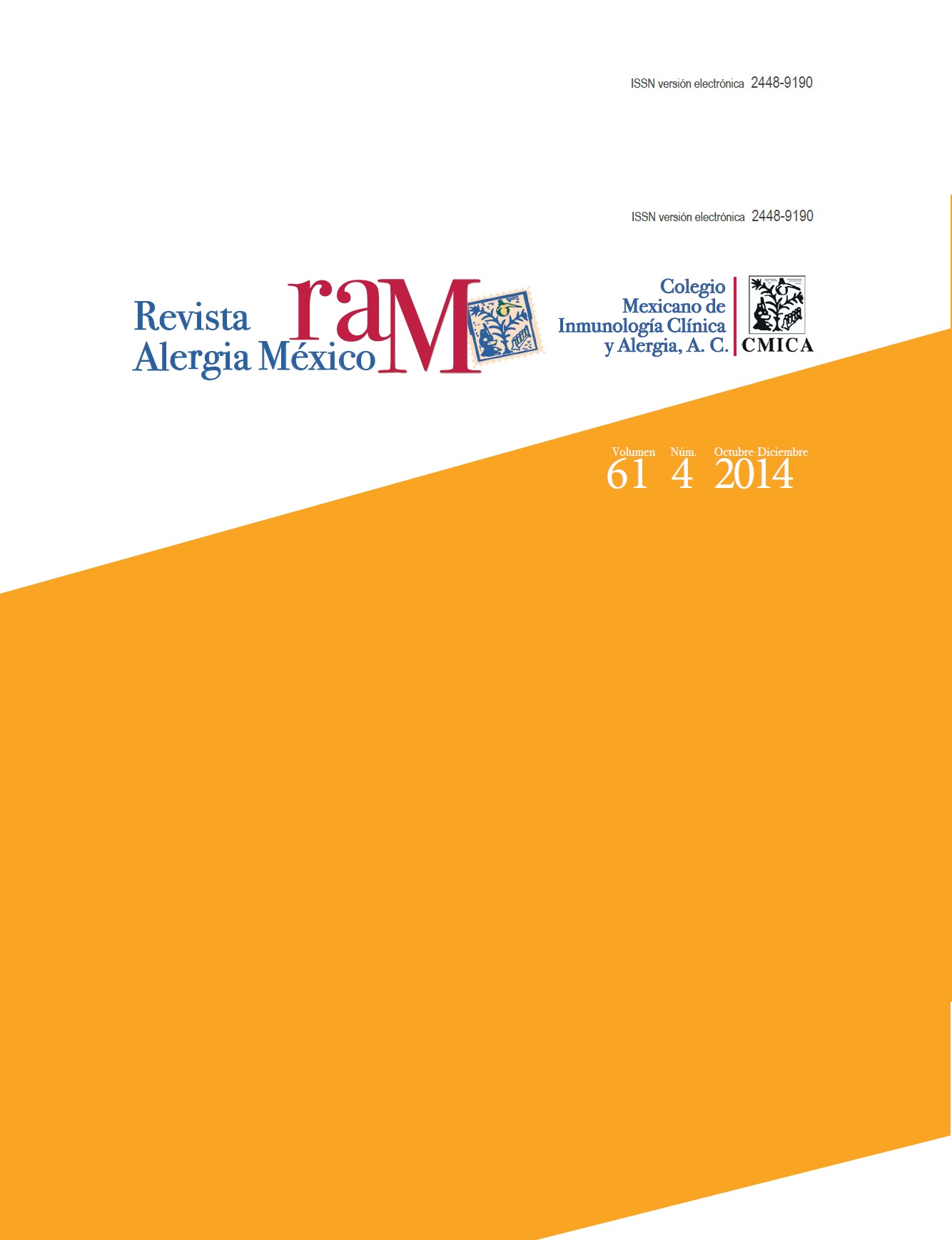Abstract
Background: Allergic rhinitis and bronchial asthma are airways chronic inflammatory processes, with a correlation of 28-78%.
Objectives: To determine the prevalence and classification of allergic rhinitis on asthmatic patients, according to the workshop Allergic Rhinitis and its Impact on Asthma (ARIA), and to assess the total serum concentrations of IgE and the presence of nasal and blood eosinophilia.
Material and method: A study was done with asthmatic patients ages 7 to 14, attending the Pediatric Service at the Hospital General del Sur Dr. Pedro Iturbe, Maracaibo, Estado Zulia, Venezuela. Subjects were polled for signs and symptoms suggesting allergic rhinitis and its impact on quality of life. Blood and nasal swab samples were taken to perform laboratory tests in study.
Results: There were 60 asthmatic patients, 73.3% males and 70% scholar age patients. The prevalence of allergic rhinitis was 93.3%, according to ARIA classification. Mild intermittent group was the most frequent type, with 42.8% the most frequent clinic sign was the allergic shiners (86.6%), and the predominant symptom was the nasal aqueous trickle (83.3%), while sleep disorders were the most common affection of quality of life (39.2%). In 85.7% of patients eosinophil percentage was higher than 3%, whereas in 75% total serum IgE values were higher than 100 Ul/mL. In patients with rhinitis, 61.9% of the nasal mucus showed altered eosinophils percentage higher than 10%.
Conclusion: A high prevalence of allergic rhinitis is present in asthmatic patients, confirmed by laboratory tests, which proves an inflammatory response mediated by IgE.
References
Bousquet J, Khaltaev N, Cruz AA, Denburg J, et al. Allergic Rhinitis and its Impact on Asthma (ARIA) 2008 update (in collaboration with the World Health Organization, GA(2) LEN and AllerGen). Allergy 2008;63:8-160.
Ellwood P, Asher M, Beasley R, Clayton TO, et al. International Study of Asthma and Allergies in Childhood (ISAAC): Phase Three rationale and method. Int J Tuberc Lung Dis 2005;9:10-16.
Koh Y, Kim C. The development of asthma in patients with allergic rhinitis. Curr Opin Allergy Clin Immunol 2003;3:159-164.
Bateman E, Hurd S, Barnes P, Bousquet J, et al. Global strategy for asthma management and prevention: GINA executive summary. Eur Respir J 2008;31:143-178.
Bousquet J, Schünemann HJ, Samolinski B, Demoly P, et al. Allergic Rhinitis and its Impact on Asthma (ARIA): Achievements in 10 years and future needs. J Allergy Clin Immunol 2012;130:1049-1062.
Tu YL, Chang SW, Tsai HJ, Chen LC, et al. Total serum IgE in a population-based study of Asian children in Taiwan: reference value and significance in the diagnosis of allergy. Plos One 2013;8:1-9.
Carosso A, Bugiani M, Migliore E, Anton JM, DeMArco R. Reference values of total serum IgE and their significance in the diagnosis of allergy in young European adults. Int Arch Allergy Immunol 2007;142:230-238.
Levin M, Le Souëf P, Motala C. Total IgE in urban Black South African teenagers: the influence of atopy and helminth infection. Pediatr Allergy Immunol 2008;19:449-454.
Vallejo G, Téllez R, González A, Mena AJC, Reynoso DVM. Implicaciones de los eosinófilos en el moco nasal de pacientes con diagnóstico posible de rinitis alérgica. An Orl Mex 2007;52:58-62.
Matsuno O, Miyazaki E, Takenaka R, Ando MN, et al. Links between bronchial asthma and allergic rhinitis in the Oita Prefecture Japan. J Asthma 2006;43:165-167.
Hong S, Son DK, Lim WR, Kim SH, et al. The prevalence of atopic dermatitis, asthma, and allergic rhinitis and the comorbidity of allergic diseases in children. Environ Health Toxicol 2012;27:2-8.
De Freitas HA, Rodríguez-Galafat J, Mujica L, De Freitas MT. Asociación entre rinitis alérgica y asma. Rev Fac Med 2009;32:7-10.
Wang ZH, Lin WS, Li SY, Zhao SC, et al. Analysis of the correlation of prevalence in allergic rhinitis and other allergic diseases. Zhonghua Er Bi Yan Hou Tou Jing Wai Ke Za Zhi 2012;47:379-382.
Han Y, Zhang H. Epidemiological investigation of allergic rhinitis in the primary school students in grade three of Shihezi city. Lin Chung Er Bi Yan Hou Tou Jing Wai Ke Za Zhi 2009;23:1074-1078.
Penaranda A, Aristizabal G, Garcia E, Vasquez C, et al. Allergic rhinitis and associated factors in schoolchildren from Bogota, Colombia. Rhinology 2012;50:122-128.
Ibero M, Justicia JL, Alvaro M, Asensio O, et al. Diagnosis and treatment of allergic rhinitis in children: results of the PETRA study. Allergol Immunopathol 2012;40:138-143.
Lee CH, Jang JH, Lee HL, Kim IT, et al. Clinical characteristics of allergic rhinitis according to allergic rhinitis and its impact on asthma guidelines. Clin Exp Otorhinolaryngol 2008;1:196-200.
Kumar N, Bylappa K, Ramesh AC, Swetha R, et al. A study of eosinophil count in nasal and blood smear in allergic respiratory diseases in a rural setup. Internet J Med Update 2012;7:40-46.
Montoro J, Del Cuvillo A, Mullol J, Molina X, et al. Validation of the modified allergic rhinitis and its impact on asthma (ARIA) severity classification in allergic rhinitis children: the PEDRIAL study. Allergy 2012;67:1437-1442.
Zicari AM, Indinnimeo L, De Castro G, Incorvaia C, et al. A survey on features of allergic rhinitis in children. Curr Med Res Opin 2013;29:415-420.
Sha JC, Zhu DD, Dong Z, Jian XD, et al. Survey on clinical characteristics of pediatric allergic rhinitis. Zhonghua Er Bi Yan Hou Tou Jing Wai Ke Za Zhi 2011;46:26-30.
Ahmadiafshar A, Taghiloo D, Esmailzadeh A, Falakaflaki D. Nasal eosinophilia as a marker for allergic rhinitis: a controlled study of 50 patients. Ear Nose Throat J 2012;91:122-124.
Gelardi M, Incorvaia C, Fiorella ML, Quaranta N, et al. The clinical stage of allergic rhinitis is correlated to inflammation as detected by nasal cytology. Inflamm Allergy Drug Targets 2011;10:472-476.
Meng CD, Dong Z, Sha JC, Li L, Zhu DD. Analysis of the lever and significance of immunoglobulin free light chain in nasal secretion and in serum of patients with allergic rhinitis and non-allergic rhinitis. Zhonghua Er Bi Yan Hou Tou Jing Wai Ke Za Zhi 2012;47:908-912.

This work is licensed under a Creative Commons Attribution-NonCommercial 4.0 International License.
Copyright (c) 2014 Revista Alergia México

